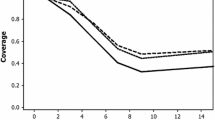Abstract
A method is proposed to estimate confidence intervals for the solution of integer linear programming (ILP) problems where the technological coefficients matrix and the resource vector are made up of random variables whose distribution laws are unknown and only a sample of their values is available. This method, based on the theory of order statistics, only requires knowledge of the solution of the relaxed integer linear programming (RILP) problems which correspond to the sampled random parameters. The confidence intervals obtained in this way have proved to be more accurate than those estimated by the current methods which use the integer solutions of the sampled ILP problems.
Similar content being viewed by others
References
F. M. Allen, R. N. Braswell and P. A. Rao, Distribution free approximation for chance constraints, Oper. Res. 22 (1974) 610.
B. Apolloni and S. Di Gregorio, A Probabilistic analysis of a new satisfiability algorithm RAIRO, Inf. Theor. 16,3 (1982) 201.
H. J. Cleef, A solution procedure for the two-stage stochastic programming with the single recouse, ZOR 25 (1981) 1.
M. R. Garey and D. S. Johnson, Computer and Intractibility: a Guide to the Theory of NP-Completeness (W. H. Freeman and Company, San Francisco, 1979).
P. Kall, Stochastic Linear Programming (Springer-Verlag, Berlin, 1978).
J. K. Lenstra, A. H. G. Rinnooy Kan and P. Van Emde Boas, An appraisal of computational complexity for operations researchers. Eur. J. Oper. Res. 11,3 (1982) 201.
C. H. Papadimitriou, On the complexity of integer programming. J. Assoc. Comput. Math. 28 (1981) 765.
K. Pearson, Tables of the Incomplete Beta Function (Cambridge University Press, Cambridge, England, 1934).
H. M. Salkin, Integer Programming (Wesley Publ. Co., London, 1975).
G. K. Sengupta, Stochastic Programming (North-Holland, Amsterdam, 1972).
G. K. Sengupta, Decision Models in Stochastic Programming. Operational Methods of Decision Making under Uncertainty (North-Holland, Amsterdam, 1982).
G. Tintner, Stochastic linear programming with applications to agricultural economics, in: Proc. 2nd Symp. Lin. Progr., ed. H.A. Autsiewicz (Springer-Verlag. 1955) p. 197.
J. W. Tukey, Non-parametric estimation III. Statistically equivalent blocks and multivariate tolerance regions. The discontinuous case, Ann. Math. Stat. 79 (1948) 30.
S. Vajda, Probabilistic Programming (Academic Press, New York, 1972).
H. J. Zimmermann and M. A. Pallatshek, The probability distribution function of the optimum of a 0–1 linear program with randomly distributed coefficients of the objective function and the right-hand side, Oper. Res. 23 (1975) 137.
S. S. Wilks, Mathematical Statistics (Wiley, New York, 1962).
Author information
Authors and Affiliations
Additional information
This research was partially supported by the Italian National Research Council contract no. 82.001 14.93 (P.F. Trasporti).
Rights and permissions
About this article
Cite this article
Apolloni, B., Pezzella, F. Confidence intervals in the solution of stochastic integer linear programming problems. Ann Oper Res 1, 67–78 (1984). https://doi.org/10.1007/BF01874453
Issue Date:
DOI: https://doi.org/10.1007/BF01874453




